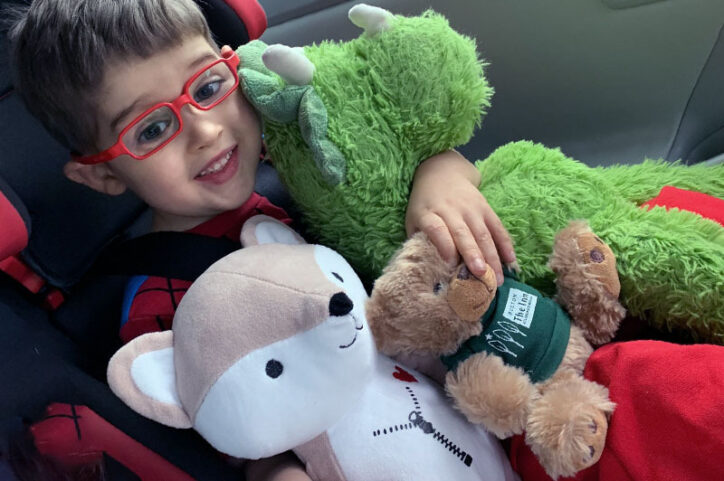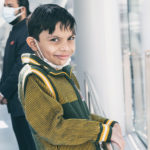Experience and innovation create a safer type of heart surgery

The Eureka moment came the day before heart surgery.
Easton Schlein wasn’t an ideal candidate for a full-scale surgical repair of an underdeveloped left ventricle. But his cardiac surgeons weren’t satisfied that they instead had to use the Fontan procedure, the only other option for that condition, but one associated with long-term liver complications.
Reviewing their surgical plan one last time, Sitaram Emani, MD, director of Boston Children’s Complex Biventricular Repair Program, and his team again studied how Easton’s ventricle had potential to circulate blood. Trusting that a last-minute change of plans would be grounded in years of experience, Emani explained to Easton’s parents they wanted to try something different.
Instead of the Fontan, the team wanted to apply elements of another procedure that treats a different condition to create a new procedure for his condition: a “reverse” double-switch 1.5 ventricle repair. This new approach would make use of his left ventricle. It didn’t take long for his parents, Julie and Marlin, to see the advantages.
Three years after surgery, Easton, now 7, runs and rides his bike without difficulty. An oxygen tank he used nearly every time he caught a cold now sits in a closet. “We don’t hold him back,” Julie says. His recovery led Emani’s team to use the procedure on 16 other children, making Boston Children’s the first hospital in the world to use the procedure as part of a strategy to surgically rehabilitate the left ventricle in patients with borderline left heart. Early results suggest this new approach is a promising alternative to the Fontan procedure and could prevent liver dysfunction and the need for a heart transplant.
“This procedure is just putting together components of procedures that we’ve been doing for years,” Emani says. “The strategy of doing it for this condition is what’s new.”
Many Fontan patients experience long-term complications
Borderline left heart is a congenital heart defect (CHD) in which the left side of the heart is smaller than normal. Emani’s team typically treats the condition with biventricular repair, a complex procedure that creates a heart with fully-functioning ventricles.
When a child’s heart anatomy isn’t ideal for biventricular repair, most surgeons recommend the Fontan procedure. It routes circulation in a way that makes one ventricle do the work of two.
But because the Fontan’s rerouting has deoxygenated blood bypassing the heart and draining directly to the lungs at lower-than-normal volume, some patients later in life experience complications such as arrhythmias and intestinal and liver diseases. For some, the cardiovascular complications eventually weaken the heart and potentially lead to a transplant. “For years,” Emani says, “Fontan was the only alternative to biventricular repair.”

Involving the left ventricle in circulation
Easton’s parents endorsed an alternative to the Fontan procedure because of his medical history. Diagnosed with a brain tumor at 19 months, Easton underwent 33 rounds of radiation. If cancer were to ever return, Julie says, treatment would be risky with a Fontan circulation.
At 2, Easton underwent staged left ventricular recruitment (SLVR), a procedure developed at Boston Children’s to rehabilitate (or “grow”) the left ventricle in hopes of an eventual biventricular repair. (Easton had hypoplastic left heart syndrome (HLHS), a related form of borderline left heart.) Although he ultimately couldn’t have biventricular repair, SLVR improved the size and function of his left ventricle.
A fully-formed left ventricle pushes oxygenated blood through the aortic valve so it can be delivered throughout the body. Despite being small, Easton’s rehabilitated left ventricle showed it could handle some of the workload of circulation and assist the right ventricle. That opened the door for the new approach.
The surgeons didn’t have to scramble to prepare; they had ample experience using a double-switch procedure to treat children who have corrected transposition of the great arteries (ccTGA). For Easton and subsequent patients, Emani’s team modified the procedure to perform a “reverse” double-switch to create a 1.5-ventricle circulation. By switching the inflow and outflow vessels to the heart and reversing their typical functions, the small left heart (the left ventricle and other parts) can handle the easier work of pumping deoxygenated (blue) blood to the lungs, while the right ventricle pumps oxygenated blood to the body.

Easton and others illustrate the power of innovation
Last year, Emani and six Benderson Family Heart Center colleagues submitted a paper that reviewed early outcomes of the first eight of these surgeries to the American Association for Thoracic Surgery.
Like Easton, the other patients had no serious complications or need for follow-up surgery. Their underdeveloped left ventricles have performed well in a supporting role. The procedure appears to give patients better pulmonary function than the Fontan does, including normal blood pressure in the lower body at 100-percent oxygen saturation. And in what could be a major development in the treatment of borderline left heart, Emani says the procedure could allow children to avoid a heart transplant.
“We knew the significance and impact if it worked,” recalls Julie. “We were hopeful it would not only save our child, but other children like him and give them all a future. Look at where we are today.”
Learn more about the Complex Biventricular Repair Program or request a second opinion.
Related Posts :
-

From Pakistan to Boston: Faiz finally found help for his complex heart condition
Don’t let his shy smile fool you. In his hometown of Lahore, Pakistan, 6-year-old Muhammad Butt is known by ...
-

Treatment for a complex congenital heart defect gives Alyvia 'endless energy'
She may be just 3 years old, but Alyvia Parker is already making a difference for other kids with congenital ...
-

Saving baby Marcela: A mother’s mission to finally hold her daughter
The translations of this page are translated from English into another language using Google Translate, a third party tool. Please ...
-

To #SavePriyanshu: A father’s reach across the world to save his son
Any parent can relate: to the ends of the earth is just the beginning of how far you will go ...





